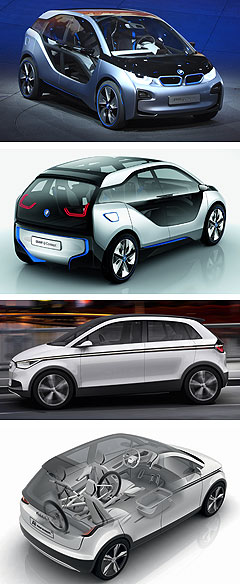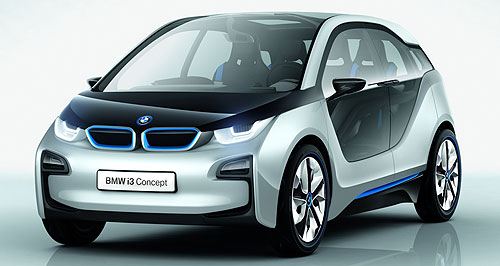Make / Model Search
News - AudiAudi attacks BMW’s carbon-fibre eco carUnveiled: The A2 concept makes its public debut on the Audi stand at the Frankfurt show. Energy generated to make carbon-fibre BMW i3 would outweigh any benefit, says Audi16 Sep 2011 By JAMES STANFORD in FRANKFURT AUDI has criticised BMW’s plan to use carbon fibre re-enforced plastic (CFRP) bodies for future city cars, alleging the CO2 emitted during the production of the material far outweighs any fuel economy benefit. GoAuto can also reveal Audi is trying to develop less energy-intensive material to replace carbon fibre, with a similar concept but replacing carbon-fibre with basalt-fibre or even waste plant-based fibres. The company hopes to use the new super-strong and light material for the A2 city car that is expected to arrive in 2015. But even then, Audi says any type of special fibre material should be used in conjunction with aluminium and sometimes steel so the car bodies remain affordable. Audi’s general vehicle development manager of Heinz Hollerweger told GoAuto that BMW was wrong to claim that using a carbon-fibre body for the i3 city car was environmentally friendly. “There is no way to recycle it and you have gained a lot of CO2 in the production,” Mr Hollerweger said. He conceded that in the case of a vehicle running a small range-extending engine, like one of the i3 models, some CO2 emissions would be prevented due to the weight savings of using carbon-fibre and subsequent fuel economy gains, but the reductions were not big enough. “With carbon-fibre, maybe there is a little bit of fuel saving, but in our calculation we have the break-even point at one million km, at least 800,000km,” Mr Hollerweger said.  Left: BMW i3. Below: Audi A2 concept. Left: BMW i3. Below: Audi A2 concept.In comparison, Audi said the payback for using significant amounts of lightweight aluminium, which is also energy intensive to produce, is between 10,000km and 30,000km depending on the vehicle. Mr Hollerweger said there was no break-even point for using an energy intensive carbon-fibre body with an all-electric vehicle that runs on green energy. The idea is that the extra energy used during the construction process is never recouped because no CO2 is produced when creating or using green energy. BMW, as is the case with all manufacturers promoting electric vehicles, often quotes green electricity, that is, electricity generated from renewable methods, to justify zero-emission claims. BMW issued a press release stating the life cycle emissions for the electric only-version of the i3 would be 30 per cent lower than an equivalent petrol car using mixed electricity sources, and 50 per cent lower if using green power. BMW said energy needed for the production of the carbon-fibres used for its CFRP panels would be generated by a hydro power plant at a Moses Lake, Washington State, plant which is a $100 million joint-venture with SGL Carbon. Mr Hollerweger said the hydro power wouldonly cover the creation of the carbon-fibres in Washington and not the other parts of the carbon-fibre panel production process including the energy intensive high-temperature curing process. This includes the creation of the raw material required to produce the carbon-fibres which will be sourced by SGL Carbon and Mitsubishi Rayon in Japan. The Washington-made carbon-fibres would then be processed into fabric at a facility in Wackersdorf, Germany, and then turned into CFRP at a plant in Landshut, also in Germany. The CFRP panels would then be sent to BMW’s Leipzig plant, where the i3 would be produced. Audi is still keen on using traditional carbon-fibre, at least for sections of its vehicles, and its Volkswagen Group parent company has even taken an eight per cent share in SGL Carbon. GoAuto was shown the body of the next Audi R8 sportscar in a special briefing at the Frankfurt motor show this week, showcasing Audi’s plan to mix carbon-fibre, aluminium and high tensile steels. Carbon-fibre is used for sections of the vehicle such as the transmission tunnel and the rear bulkhead, while other parts are made of aluminium. The different materials are glued and bolted together using a similar process to the way steel and aluminium body parts are joined for Audi models such as the TT sportscar. It is this combination of various materials that Audi says will allow it to achieve low weight targets, but retain affordability. Audi’s head of electro-mobility, Franciscus van Meel, said: “Our policy is to combine materials, using the right material for the right part of the car, rather than sticking to one option.” In the case of the A2 city car, which the company showed in concept form at Frankfurt, Audi said it would be able to limit the weight of the electric version to just 1150kg, which is an aggressive target considering the traditional heft of battery packs. Audi board member for technical development, Michael Dick, said the process of mixing light metals and CFRP or an equivalent material was the best way. “With a mixed design like we have here, you can make a car that is lighter and at the same time have a car that uses fewer resources than you would otherwise with a CFRP car,” he said. Audi knows only too well that using expensive materials for a small car can cause problems, as its first generation A2 model, which ran from 2000 to 2005, was not able to make any money because its all-aluminium construction cost too. Audi said it should avoid this situation with the mixed materials policy for the new A2. “We have to be able to reach the cost targets for the A2 and they are considerably more demanding than this (second-generation R8) car,” Mr Dick said. Audi will be able to save money if it can industrialise its alternate carbon-fibre material, partly because it could be cured at a far lower temperature than carbon-fibre, which saves both money and reduces CO2 emissions. The head of Audi’s Lightweight Design Centre, Dr Lutz-Eike Elend, said Audi has been working on its alternative to carbon-fibre for 18 months. “We know very well the advantages of carbon-fibre but we are also very familiar with the disadvantages of carbon-fibre that is the high amount of energy that you have to utilize to produce it. So we are working full steam ahead on other fibres as well,” he says. Carbon-fibre is known for being super light but also remarkably strong thanks to its woven core structure, something Audi is attempting to recreate with the new materials it is testing. “You have nearly the same properties with these other fibres as you do carbon-fibre, the problem that does exist is that the mechanical variance is wide and we are working with our suppliers to eliminate this problem,” Dr Elend said. While Audi remains hopeful it can put its cheaper carbon-fibre alternative into production is says it will not do so until it meets its high quality requirements. “We have been able to achieve the mechanical properties, but what we really need is the stability of these mechanical properties and this is not something we will be achieving for the next R8, but it could be for the A2 concept if it goes into production.”  Read more |
Click to shareMotor industry news |











Facebook Twitter Instagram